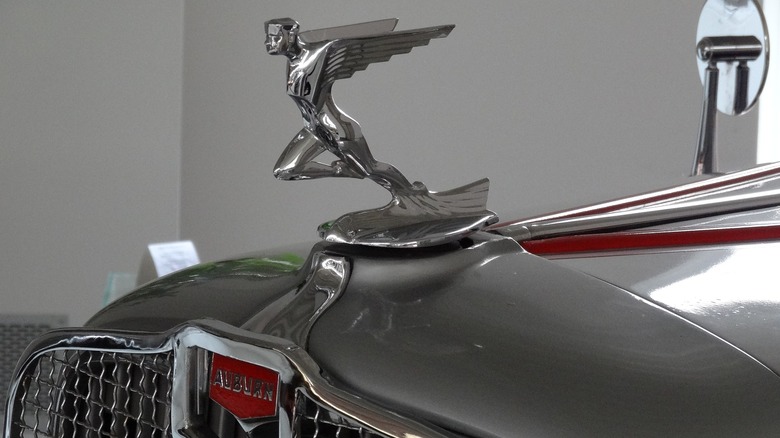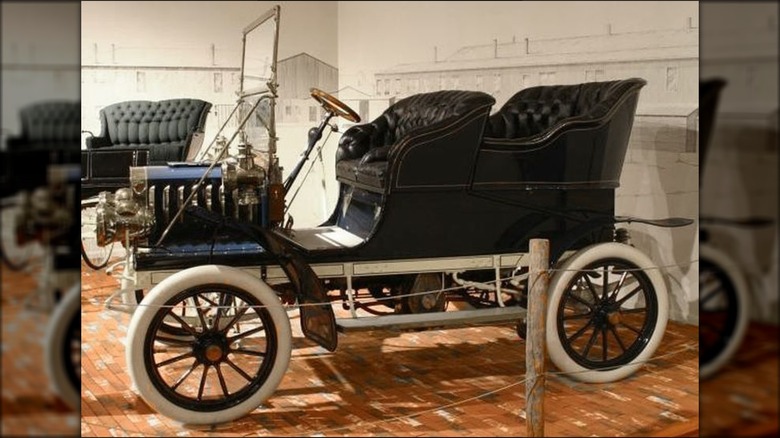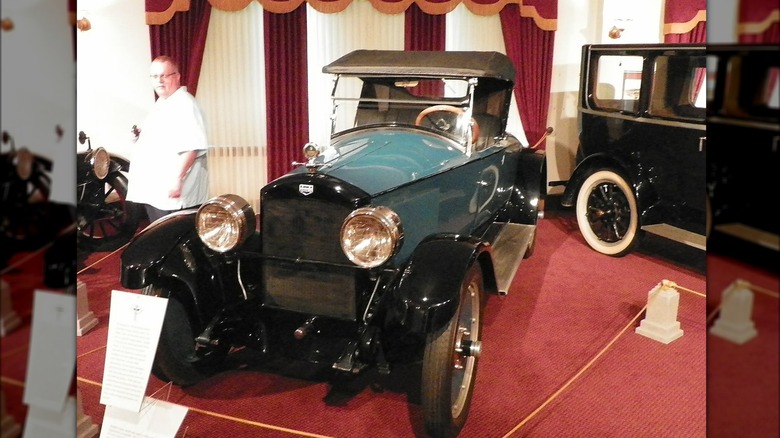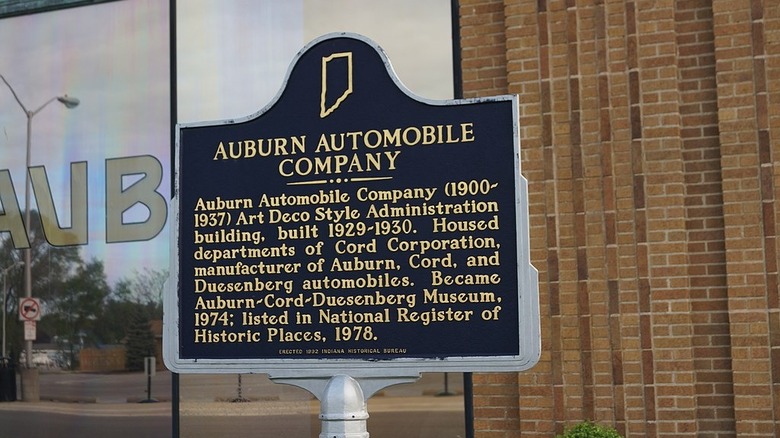What Happened To The Auburn Automobile Company?
No one will blame you if you've never heard of the Auburn Automobile Company (AAC) as the Indiana automaker took the song lyric "it's better to burn out than to fade away" quite literally. Despite making cars for only 33 years, the company created some of the most coveted vehicles on the road. They were fast, equipped with some of the most advanced technological innovations of the day, and had aggressive, eye-catching styling that made them look incredible. And they were expensive.
But, like many companies that flourished during the Roaring '20s, the Great Depression put the kibosh on its success. In order to see just how fast and furious the Auburn Automobile Company's legacy truly was, we're jumping back to 1874 when Charles Eckhart founded the Eckhart Carriage Company in Auburn, Indiana. His two sons, Frank and Morris, later joined the business.
For a quarter of a century, the Eckharts built horse-drawn spring buggies. However, as early motor cars took hold and spawned a revolution that washed across the globe, the brothers turned their sights towards the future. They changed the name to the Auburn Automobile Company (in 1900) and set about building their very own cars.
Despite possessing the in-house knowledge and employees who could build bodies, the first automobile didn't become publicly available until 1903. The open-air chain-driven runabout was powered by a single-cylinder, water-cooled engine that kicked out about six horsepower.
[Featured image by Klaus Nahr via Wikimedia Commons | Cropped and scaled | CC BY-SA 2.0]
Auburn rolls onto the world stage
The purchase price for that first Auburn was a staggering $1,450. Let's put that into perspective. That sum of money in 1900 equates to $53,238 today. Keep in mind that at the turn of the 20th century, the average annual household income was only $3,000. It was a time when most homes didn't have indoor plumbing, phones were uncommon, and most people were still riding around in horse-drawn wagons.
Due to the exorbitant cost, they only sold 50 cars, but this was enough to inspire the brothers to incorporate Auburn Automobile Company (in 1903) and move forward with building more cars. In 1912, it made its first fully closed automobile, the Auburn Model 40.
Over the next several years, the company made a number of models, including two-door roadsters, four-door sedans, and five and seven-passenger touring cars (along with versions with detachable tops) powered by everything from two-cylinder to big six-cylinder motors.
Bad timing struck in 1915 when Charles Eckhart died. Frank and Morris took over, but World War I forced them to close shortly after because the raw materials used to build automobiles were instead needed to make tanks, jeeps, and airplanes. So, with the company heading towards receivership and a dim future ahead of them, the sons decided to sell the company. It remained on the market until a group of investors from Chicago purchased the company in 1919.
[Featured image by DougW via Wikimedia Commons | Cropped and scaled | CC BY PUBLIC DOMAIN]
Beauty is in the eye of the beholder
The small town of Auburn was less than 200 miles away from the big metropolis of Chicago, and many locals referred to this new investment group as the "Chicago Gang." No doubt thanks to the Windy City's reputation for having some of the country's most dangerous organized crime families. Ironically, they were anything but.
The group was led by Ralph Austin Bard, who eventually became Assistant Secretary of the Navy under President Franklin Delano Roosevelt and later Undersecretary of the Navy under both President Roosevelt and President Harry S. Truman. Another of the investors in this so-called "gang" was William Wrigley, Jr., of the chewing gum empire and (at the time) part-owner of the Chicago Cubs baseball team.
By then, Frank had retired and was living his best life in Los Angeles, leaving Morris to manage the company. The first car produced under this new ownership (in 1919) was the Beauty-Six, a vehicle the Eckharts fully designed before selling the company. Despite using the same chassis found in many of Auburn's previous models, it helped spread Auburn Automobile Company's fame far and wide.
But this beauty looked very different from those that came before. Not only did it have a sportier, fenderless, streamlined body, but it also included an integrated radiator shell. As the name implies, the new Auburn was powered by a 230.9-cubic-inch Continental straight six-cylinder engine producing 43 horsepower.
[Featured image by sultmhoor via Wikimedia Commons | Cropped and scaled | CC BY-SA 2.0]
Cord was able to turn back time -- for a minute
The Beauty-Six was marketed nationally and, with a sticker price of "just" $1,595, sold more than 6,000 units (a new company record). Then, in 1920, a brief, severe recession hit the United States.
The Forgotten Depression (not the "Great Depression" that would come later that same decade) was an 18-month period caused by the global economic turmoil following WWI. It saw the U.S. stock market drop in value by almost 50% and corporate profits decline by more than 90%.
By 1924, Auburn was still making cars, but not a profit. The hiring of Errett Lobban Cord changed that. If the name sounds familiar, he was known not just for his work at Auburn but also for owning a host of other companies such as Duesenberg, Lycoming Motor Works, Aviation Corp. (American Airways), Checker Cab Manufacturing Corp., and New York Shipbuilding Corp.
Before all that, Cord worked at Moon Automobile Company in Chicago and went from salesman to general manager, then director in less than five years. Some sources claim he was simply hired as the vice president and general manager for Auburn but quickly made president within a year or two.
Other sources say Cord knew the investment group was looking to sell and made a counterproposal. He would forgo a salary in exchange for 20% of the profits, the power to make all decisions, and the right to purchase the company when it made money again.
[Featured image by Time Inc. via Wikimedia Commons | Cropped and scaled | CC BY PUBLIC DOMAIN]
The Roaring 20's roared with speed!
In 1926, Cord not only bought Auburn Automobile Company but also Duesenberg Automobile and Motors Company of Indianapolis. Duesenberg was famous for its racing cars, having won four Indy 500 races during the Roaring '20s. He rolled Duesenberger Inc. (the new name) under the Auburn brand to make it his new line of luxury cars, much in the same way Lexus is the luxury brand under Toyota.
Cord brought on James Crawford as chief engineer and began building the highly stylized "streamer" cars with their distinctive swept-back bodies that flowed from the rounded radiator shell up front down both sides all the way to the back.
In 1927, Cord bought up several existing automobile manufacturing plants in Connersville, Indiana, and remodeled them into a 1.5-million-square-foot facility with the ability to build 400 bodies and 250 completed cars a day. The following year (1928) saw the introduction of the Duesenberg Model J and Auburn's Speedster. The Model J became the vehicle of choice for the rich and famous, like Al Capone, Mae West, and European aristocracy. In fact, it made it on our list of the 10 most luxurious classic American cars ever made.
In 1929, the Connersville factory rolled out its first cars, including the L-29 Cord, America's first mass-produced front-wheel-drive vehicle. Cord founded the Cord Corporation, a holding company for Auburn and at least 100 other businesses he was involved with — thus, the Time Magazine cover heralding his "Kingdom of Cord."
[Featured image by Michael Gaylard via Wikimedia Commons | Cropped and scaled | CC BY-SA 2.0]
RIP AAC
On October 29, 1929, the New York Stock Exchange crashed. Somehow, Cord managed to avoid the worst of it, and Auburn and Duesenberg stayed afloat for a few more years. In fact, in 1931, the Auburn Automobile Company sold 34,000 cars (a new company record) with more than 100 international dealers and distributors in over 90 countries. Auburn continued to roll out new cars, including ones powered by 12-cylinders, a line made entirely from steel, supercharged speedsters, and the Cord 810 (1936). All to no avail. However, before it was all said and done, the Auburn, Cord, and Duesenberg collective created some of the fastest pre-war cars.
Cord had been able to keep most of his fortune out of the stock market before 1929, but he started playing fast and loose in the wake of the collapse and summarily got into trouble. In 1934, he was forced to move his family from the U.S. to England because of kidnapping threats. Two years later, after returning to America (in 1936), the Securities and Exchange Commission began investigating stock trades involving his Checker Cab stock. Finally, in April of '37, he was admitted to a Chicago hospital for what was reported as much-needed rest.
The last of the Auburn, Cord, and Duesenberg vehicles rolled out of the Connersville factory on August 7, 1937. This coincided with a federal court order that resulted in Cord selling off all of his holdings in Cord Corporation for two million dollars, thus putting an end to Cord's Kingdom.
[Featured image by Greg Gjerdingen via Wikimedia Commons | Cropped and scaled | CC BY-SA 2.0]





